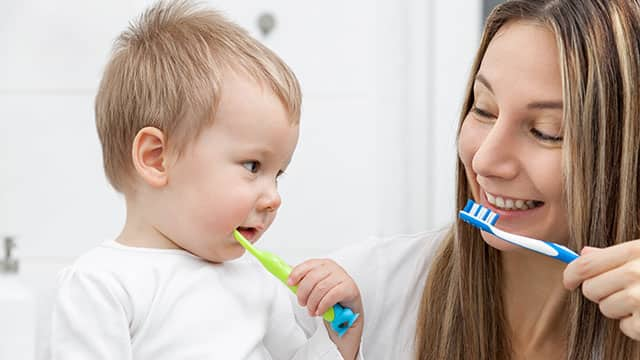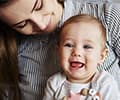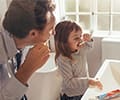How to Brush Your Baby’s Teeth
Baby teeth play a huge factor in a child’s oral health. However, before their pearly whites erupt, their gums should also be cared for. The ADA recommends that simply wiping their gums with a wet washcloth or gauze can help prevent plaque buildup. Once their teeth erupt, you will need to brush your baby’s teeth. Here’s how:
- Make sure your baby is in a comfortable position that allows you to easily reach into their mouth.
- Place a smear or rice sized amount of fluoride toothpaste on a soft-bristled baby toothbrush.
- Using circular or wiggling motions, brush the surface of the teeth and along the gumline.
- Brush your baby’s teeth after eating and before bed. Remember to clean between their teeth when two teeth touch.
Why Baby Teeth are Important
You may not realize it, but the importance of baby teeth can't be understated. Baby teeth help your child with:
- Speaking
- Smiling
- Chewing
- Space holding
Space holding may be the most important aspect of caring for your baby’s teeth early on. While your child’s teeth start filling in, they are in fact reserving a space in the jaw for their future permanent adult teeth. However, suppose a baby tooth is lost prematurely. In that case, the adult tooth might drift where it shouldn't, leading to overcrowding and a crooked smile. It is likely the baby tooth was lost due to decay and cavities. At a young age, cavities can be quite painful for your little one. No parent wants that! This makes it even more important to perform good oral care from the time they're infants. Plus, daily brushing and watching their sugar intake will help. It's never too early to be healthy!
When Does Teething Begin
Teething is one of the first recognizable signs of growth with your baby. You'll most likely experience the baby's irritability from the discomfort of teething well before you actually see any teeth pop out. The ADA says you might see them start erupting anywhere from 6 months to 1 year. By the time their third birthday rolls around, they should have a full smile of all 20 baby teeth. A baby teething chart can also help make sure all of their teeth come in as they should. Typical teething symptoms include:
- Frequent drooling
- Fussiness
- Irritability
- Loss of appetite
- Trouble sleeping
Teething can be a stressful time however, these tips will help get everyone through the teething stage. If your child experiences a fever, diarrhea, or rash while teething, you should speak to your pediatrician.
How to Start Brushing your Toddler’s Teeth
Young children can’t brush their own teeth well enough, so they need an adult to do it for them. Here’s are some guidelines to follow to help you brush your properly toddler’s teeth:
- Start by finding a comfortable position. This could be with your child sitting on your lap facing away from you with their head resting against your body while you cup their chin with one hand.
- Brush the teeth using a pea sized amount of toothpaste if your child is old enough to spit it out.
- Brush gently in small circles. Brush along the inside surfaces and the outside surfaces and along the gumline.
- Brush back and forth on the chewing surfaces of teeth.
- After brushing, ask your child to spit out toothpaste, and not to rinse with water. The small amount of toothpaste remaining keeps protecting teeth.
Tips to Make Tooth Brushing Fun for Toddlers
It’s hard to get toddlers to do anything they don’t want to do. Brushing your toddler’s teeth can be a challenge, but it doesn’t have to be. Make it fun by singing a song that lasts two minutes or distract them by giving them a separate toothbrush to use on a stuffed toy. Have them pretend to be an animal and roar like a lion to get them to open their mouth. You can also try buying flavored toothpaste or character themed toothbrushes to make teeth brushing more interesting. If your child wants to brush their teeth themselves, try taking turns. This way you’re encouraging independence while ensuring that they get their teeth clean enough.
It is recommended to take your child to the dentist when they turn one or when their first tooth pops out. Proper brushing with fluoride, cleaning between teeth, regular dental checkups, and a healthy diet are your baby's best friends: that and a teething ring!
Oral Care Center articles are reviewed by an oral health medical professional. This information is for educational purposes only. This content is not intended to be a substitute for professional medical advice, diagnosis or treatment. Always seek the advice of your dentist, physician or other qualified healthcare provider.
ORAL HEALTH QUIZ
What's behind your smile?
Take our Oral Health assessment to get the most from your oral care routine
ORAL HEALTH QUIZ
What's behind your smile?
Take our Oral Health assessment to get the most from your oral care routine
Join Us
Get the best of your oral health routine and take it to the next level with expert advice, recommendations, products and solutions and special offers.
Join Us
Get the best of your oral health routine and take it to the next level with expert advice, recommendations, products and solutions and special offers.















